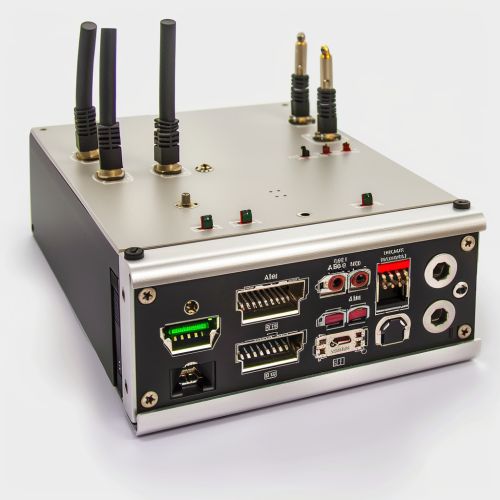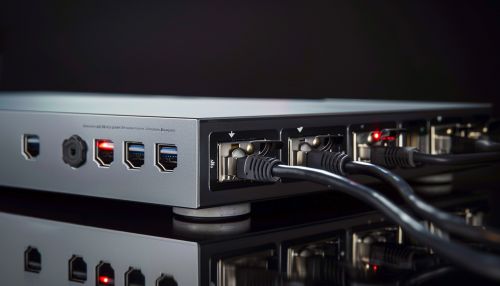Modems: Difference between revisions
(Created page with "== Introduction == A modem, short for modulator-demodulator, is a hardware device that converts data between digital and analog forms for transmission over communication channels. Modems are crucial in enabling digital devices to communicate over analog mediums such as telephone lines, radio waves, and cable systems. This article delves into the technical aspects, types, history, and applications of modems. == History of Modems == The development of modems dates back...") |
No edit summary |
||
| Line 82: | Line 82: | ||
The future of modem technology is closely tied to advancements in communication networks and standards. Emerging technologies, such as [[5G]] and [[fiber-to-the-home]] (FTTH), promise to deliver even higher data transmission rates and lower latency. Additionally, the integration of artificial intelligence (AI) and machine learning (ML) in modem design and operation is expected to enhance performance and efficiency. | The future of modem technology is closely tied to advancements in communication networks and standards. Emerging technologies, such as [[5G]] and [[fiber-to-the-home]] (FTTH), promise to deliver even higher data transmission rates and lower latency. Additionally, the integration of artificial intelligence (AI) and machine learning (ML) in modem design and operation is expected to enhance performance and efficiency. | ||
[[Image:Detail-91547.jpg|thumb|center|Modern modem device with multiple ports and indicators.|class=only_on_mobile]] | |||
[[Image:Detail-91548.jpg|thumb|center|Modern modem device with multiple ports and indicators.|class=only_on_desktop]] | |||
== See Also == | == See Also == | ||
Latest revision as of 18:41, 20 June 2024
Introduction
A modem, short for modulator-demodulator, is a hardware device that converts data between digital and analog forms for transmission over communication channels. Modems are crucial in enabling digital devices to communicate over analog mediums such as telephone lines, radio waves, and cable systems. This article delves into the technical aspects, types, history, and applications of modems.
History of Modems
The development of modems dates back to the 1950s when they were first used for military and government applications. The earliest modems were designed to facilitate communication between computers over long distances using telephone lines. The first commercial modem, the Bell 103, was introduced by AT&T in 1962, offering a data transmission rate of 300 bits per second (bps).
Evolution
Over the decades, modem technology has evolved significantly. The introduction of the Hayes Smartmodem in 1981 revolutionized the market by incorporating a command set that allowed computers to control the modem directly. This innovation led to the widespread adoption of modems in personal computing.
The 1990s saw the advent of faster modems, such as the V.34 and V.90 standards, which increased data transmission rates to 33.6 kbps and 56 kbps, respectively. The development of DSL and cable modem technologies in the late 1990s and early 2000s further enhanced internet connectivity speeds, making broadband internet widely accessible.
Types of Modems
Modems can be classified into several types based on their functionality, medium of transmission, and technology.
Dial-up Modems
Dial-up modems use the public switched telephone network (PSTN) to establish a connection to the internet. These modems convert digital data from a computer into analog signals that can be transmitted over telephone lines. The maximum speed of dial-up modems is typically 56 kbps, which is relatively slow compared to modern broadband technologies.
DSL Modems
DSL modems use existing telephone lines to provide high-speed internet access. Unlike dial-up modems, DSL modems can transmit data at much higher speeds, ranging from hundreds of kbps to several Mbps. DSL technology includes various standards such as ADSL, SDSL, and VDSL.
Cable Modems
Cable modems provide internet access via the same coaxial cables used for cable television. These modems offer significantly higher speeds compared to dial-up and DSL modems, typically ranging from 10 Mbps to 1 Gbps. Cable modems use the DOCSIS standard to facilitate data transmission over cable networks.
Fiber Optic Modems
Fiber optic modems, also known as optical network terminals (ONTs), use fiber optic cables to deliver internet access. These modems offer extremely high data transmission rates, often exceeding 1 Gbps. Fiber optic technology is known for its low latency and high reliability, making it ideal for applications requiring large bandwidths.
Wireless Modems
Wireless modems connect to the internet using cellular networks or other wireless technologies. These modems include 3G, 4G, and 5G modems, which provide mobile internet access with varying speeds and coverage. Wireless modems are commonly used in mobile devices, laptops, and remote locations where wired connections are impractical.
Technical Aspects
Modems operate by modulating digital signals into analog signals for transmission and demodulating received analog signals back into digital form. This process involves several technical components and protocols.
Modulation Techniques
Modulation is the process of varying a carrier signal to encode digital information. Common modulation techniques used in modems include:
- **Amplitude Modulation (AM)**: Varies the amplitude of the carrier signal.
- **Frequency Modulation (FM)**: Varies the frequency of the carrier signal.
- **Phase Modulation (PM)**: Varies the phase of the carrier signal.
- **Quadrature Amplitude Modulation (QAM)**: Combines amplitude and phase modulation to increase data transmission rates.
Error Correction and Compression
To ensure data integrity and efficiency, modems employ error correction and data compression techniques. Error correction methods, such as FEC and ARQ, detect and correct errors in transmitted data. Data compression algorithms, such as V.42bis and MNP5, reduce the amount of data transmitted, improving overall transmission speed.
Protocols
Modems use various protocols to establish and maintain communication. Some of the key protocols include:
- **Point-to-Point Protocol (PPP)**: Used for establishing direct connections between two network nodes.
- **Serial Line Internet Protocol (SLIP)**: An older protocol for connecting to the internet over serial lines.
- **Transmission Control Protocol/Internet Protocol (TCP/IP)**: The fundamental protocol suite for internet communication.
Applications of Modems
Modems have a wide range of applications in various fields, including telecommunications, internet access, and remote monitoring.
Telecommunications
In telecommunications, modems are used to transmit voice, video, and data over long distances. They play a crucial role in PSTN, ISDN, and VoIP systems, enabling efficient and reliable communication.
Internet Access
Modems are essential for providing internet access to homes and businesses. They connect users to internet service providers (ISPs) and facilitate data exchange over the internet. The choice of modem technology, such as DSL, cable, or fiber optic, depends on the available infrastructure and required bandwidth.
Remote Monitoring and Control
Modems are used in remote monitoring and control systems, such as SCADA and IoT applications. These systems rely on modems to transmit data from remote sensors and devices to central monitoring stations, enabling real-time data analysis and decision-making.
Future Trends
The future of modem technology is closely tied to advancements in communication networks and standards. Emerging technologies, such as 5G and fiber-to-the-home (FTTH), promise to deliver even higher data transmission rates and lower latency. Additionally, the integration of artificial intelligence (AI) and machine learning (ML) in modem design and operation is expected to enhance performance and efficiency.


